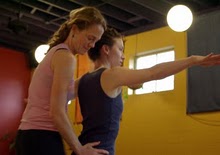 True confessions time . . . when you think of yoga, what comes to mind? Incense? Hippies? Being asked to put your leg behind your head? I am here to tell you as a triathlete and a yoga teacher that yoga will make you a better athlete. Yoga will help you gain more flexibility, strength, and balance. Spending time on your yoga mat will also help you become stronger mentally. Yoga is also a tried and true way to prevent injuries, if that yoga is done specifically for athletes. You can benefit by adding a yoga practice to your training plan by specifying your yoga practice to your current mesocycle. Yoga is typically regarding by athletes as a stretching routine – indeed, visions of Cirque De Soleil may come to mind. However, a yoga practice designed for the athlete will help lengthen and stretch tight muscles. This will promote the use of your full range of motion. Tight muscles are prone to injury, especially when we engage in activities that use repetitive motions such as swimming, biking and running. Stretching will help your body process lactate after exercise and will improve muscle oxygenation. Yoga will also help you strengthen your body as a whole. A yoga practice for athletes involves poses that use “static holds” – such as holding your body in a push-up position – and poses that “flow” from one to the other, such as a Sun Salutations. A crucial component to strength for an athlete is your core strength. To build core strength in, you can use static holds, flowing from pose to pose, along with specifically targeted sit-ups. It is very important to practice all poses with correct alignment. This will promote joint stability by not only by strengthening the muscles in your body, but also the ligaments and tendons that are connected to those muscles. Holding challenging poses will strengthen your mental fortitude. Learning to use your breath to relax will hold you firm, and help you to endure the immediate physical and emotional challenges. When you take yourself out of your “comfort zone” and hold a challenging yoga pose, you will actually learn how to endure. Learning to relax while facing discomfort will promote better performance and a more efficient recovery. Yoga will teach you balance. It will teach you balance by engaging you in balance poses. You will also learn the value of being in the moment. How do you deal with hitting a wall? What motivation do you tap into when you lace up while it’s still dark outside and temperatures are frigid? Why do you do what you do when you just don’t feel like you can? Being in different yoga postures, whether you are standing, sitting, or upside-down will bring these answers to you. Most of the injuries that athletes experience are from the repetitive motions that are typical of endurance sports. Even a slight imbalance can pull the body out of alignment. The subsequent “pounding” that our bodies experience can lead to inflammation and damage to the ligaments, tendons, and muscles. Engaging in a regular yoga practice designed for athletes will help you develop symmetrical body alignment, and it will correct any physical imbalances that may be developing. Also, yoga will allow you to develop a more holistic view of your body, meaning you will begin to feel and intuitively know when you are out of alignment. Where you practice yoga is key to your training. Practicing yoga in a class or in a private lesson will allow you to work with a teacher who will point out imbalances that you may not know exist. A solo practice is a great opportunity to work with the strengths and weaknesses that you have identified. If you considering beginning a yoga practice, it is recommended that you use both classes and your own practice to fully complement your training. And it is important to speak with your medical provider about beginning and developing your yoga practice. How can you use yoga to complement your athletic training? Simply put, the intensity of your yoga practice should be in inverse proportion to the intensity of your mesocycle. In the low intensity of your base cycle of your training you will benefit from a vigorous yoga practice that includes a power yoga class or a home practice that includes a strong flow through the strength building poses. The heat of a strong yoga practice during your base cycle will complement your work for aerobic gains and also develop muscles, tendons and ligaments by promoting full range of motion. At the same time, you will build your core strength and promote balance. It is beneficial to decrease the intensity of your yoga practice as you enter your Build Cycle. This is the time to switch to gentler stretches and enjoy spending more time on the floor. Focusing on hips and hamstrings at this time is warranted. The goal at this point in training is to maintain what you have gained from your Base Period while promoting flexibility and encouraging a speedy recovery as the intensity in your training increases. As your body-mind awareness increases, yoga will give you the opportunity to notice if an injury is forming and if you are overtraining. When you reach your Peak Period, it is appropriate to eliminate intensity in your yoga practice. Overdoing it will affect your race performance. This is a great opportunity to practice restorative yoga. Restorative yoga uses long relaxing holds and often uses various props for support. You can also use this time to focus on the breath and meditation to calm any nervous energy that may be brewing! Using common sense is of the utmost importance. If you are going to a vigorous and hot class, treat this as a strength workout that you would typically do on a “light day.” Schedule a gentle or restorative class on days when you have completed a tough or brick workout. Make sure that your yoga practice complements your daily training. For example, if you’ve been swimming, engage in a yoga practice that includes shoulder work and lateral stretches; if you have been biking, running, or skiing, focus on your hips and hamstrings – moreover, the off-road athlete will benefit from a yoga routine that incorporates balance and core-strength. Just as we work with limiters in our endurance training, we work with limiters in our yoga practice. If you’re ready to begin a yoga practice, find a local gym or studio that offers classes and show up! Make sure to speak to the instructor before class and tell the instructor if you are a beginner, have any injuries, and where you are in your training cycle. If you would like to begin with a home practice you can keep it very simple and usable. To warm up, you can use very gentle stretches, core work, and balance to get your body ready for your workout. After your workout, when you are warm and most pliable, use some hip-opening poses, forward folds, and twists to cool down. Please note that workouts lasting longer than 2.5 hours should only include a very gentle stretching routine. Your ligaments, tendons, and muscles have already been taxed; there is no reason to further tax and potentially damage your body. The most important thing to remember – Have Fun! Enjoy your training and don’t take yourself too seriously. Work hard, play hard, and honor the value of rest and recovery. I hope to see you out there! Good Luck and Namaste! Meghan P.S.: This article appears in Al Lyman's Endurance Scoop newsletter.... check it out!!!! http://www.coach-al.com/newsletter/2009_issue03.htm#MeghanGuest Comments are closed.
|
Archives
December 2020
Categories
All
|

 RSS Feed
RSS Feed